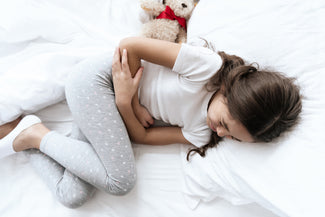Your Cart is Empty
Free Shipping on ALL alarms!
And on all orders of $35 or more *Continental US only
Free Shipping on ALL alarms!
And on all orders of $35 or more *Continental US only

Constipation as a cause of or contributing factor in bedwetting and daytime wetting should not be overlooked. Constipation is the Number 1 source of belly pain for kids and is often something parents are surprised to discover. A visit to the ER for abdominal pain and an X-ray that demonstrates constipation identifies this common problem. Constipation not only causes abdominal pain but is a common cause of daytime accidents, urinary tract infections and even bedwetting.
X-ray for Diagnosis
You don’t have to wait for abdominal pain to present before treating your child for constipation. The tricky part is that parents and even your health care provider may not think of constipation, especially in children who are good eaters and produce some poop every day. A simple x-ray can help diagnose constipation.
Stool Leaking
Children who have stool leakage, called encopresis, are always constipated. It is not a behavioral problem, but a physiologic problem. There is a solid mass of stool in the bowel, which cannot be evacuated. The liquid stool seeps around this mass and comes out into the underwear. Often the child doesn’t get warning that this is happening until it is too late. They do not have the feeling that they need to use the bathroom because the stretched-out rectum no longer gives the signal to their brain.
11 Signs Your Child is Constipated
(Hodges, Steve. “Its No Accident”) 2012
Treatment
Constipation should be treated aggressively. Hodges most recent research indicates that daily enemas are the treatment of choice. A Fleets enema or a glycerin suppository can be used once a day. Most families find that a time after dinner and before bed is a good time. Your child should try to hold the liquid as long as possible, but most find a bowel movement occurring within 5-10 minutes.
Parents worry that a daily enema is too much or that it is habit forming. Current research indicates that the daily enema should be used long enough for the bowel to regain the tone it lost while being stretched out with the large amount of stool. This may mean enemas for a month or two.
After two weeks of enemas, Miralax can be started to keep the stool soft. You can start with one capful every day. This, combined with enemas, helps keep the colon cleaned out.
Progress
You should see less frequent voiding during the day, less rushing to the bathroom, fewer wetting accidents and regular mushy daily bowel movements. As results are seen, enemas can be changed to every other night for a month, slowly tapered and then discontinued. Miralax can be used for several months to maintain regularity.
Children with constipation require treatment for more than a day! It can take weeks to several months for the bowel to regain its tone.
Diet
While you are treating the constipation, now is a good time to look at your child’s diet. Kids’ diets should include lots of foods that are naturally rich in fiber to help keep poop soft. Whole grains, nuts and seeds, and beans are high in fiber. Fruits and vegetables are especially great because they’re high in fiber AND fluid–and fluid is vital for keeping stool moving through the system. Supplements such as Benefiber, dissolved in fluid, even fiber gummies (3 grams fiber/gummy) or fiber bars may help.
Some high-fiber fruits and veggies include:
When you choose foods for your family, read the labels and choose high fiber breads, cereals, pasta, tortillas, etc. Cow’s milk and cheese can be constipating. Limiting the amount or changing to soy or almond milk may help.
Comments will be approved before showing up.